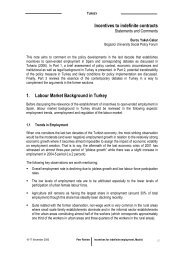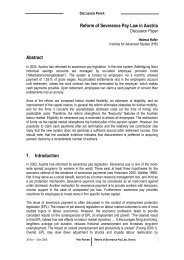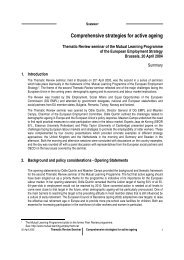Discussion Paper from Belgium on The "Rosetta Plan" - A ...
Discussion Paper from Belgium on The "Rosetta Plan" - A ...
Discussion Paper from Belgium on The "Rosetta Plan" - A ...
Create successful ePaper yourself
Turn your PDF publications into a flip-book with our unique Google optimized e-Paper software.
<str<strong>on</strong>g>Discussi<strong>on</strong></str<strong>on</strong>g> <str<strong>on</strong>g>Paper</str<strong>on</strong>g> From Host Country Government: <str<strong>on</strong>g>Belgium</str<strong>on</strong>g><br />
<str<strong>on</strong>g>Discussi<strong>on</strong></str<strong>on</strong>g> <str<strong>on</strong>g>Paper</str<strong>on</strong>g> <str<strong>on</strong>g>from</str<strong>on</strong>g> <str<strong>on</strong>g>Belgium</str<strong>on</strong>g> <strong>on</strong><br />
<strong>The</strong> "<strong>Rosetta</strong> Plan" - A Springboard for<br />
Young People into Employment<br />
(<strong>The</strong> First Job Agreement)<br />
by<br />
Federal Ministry of Employment and Labour<br />
First job agreements are part of the co-operati<strong>on</strong> agreement c<strong>on</strong>cluded between the Federal<br />
Government and the federate entities, which stands for a preventive approach of youth unemployment.<br />
Young people have thus the opportunity to acquire some vocati<strong>on</strong>al experience via a first job<br />
agreement.<br />
Goals<br />
<strong>The</strong> aim of the first job agreement is to offer, as so<strong>on</strong> as possible, to young people a job or a training<br />
and a job or an apprenticeship.<br />
This should:<br />
• avoid that young people would get stuck in unemployment;<br />
• improve their vocati<strong>on</strong>al educati<strong>on</strong> skills necessary for a l<strong>on</strong>g-term integrati<strong>on</strong> in the labour market.<br />
This aim meets the guideline as well as the specific needs of the Belgian labour market.<br />
In order to encounter the specific difficulties experienced by certain young people, the youth<br />
employment plan is subject of a co-operati<strong>on</strong> agreement between the Regi<strong>on</strong>s. This agreement focuses<br />
<strong>on</strong> regi<strong>on</strong>al and community initiatives in the field of placement and training for young people who d<strong>on</strong>'t<br />
hold a certificate of higher sec<strong>on</strong>dary educati<strong>on</strong> (integrati<strong>on</strong> path replacing the m<strong>on</strong>itoring of the<br />
unemployed) as well as the role of the sub-regi<strong>on</strong>al Employment Committees.<br />
<strong>The</strong> obligati<strong>on</strong> for the employers in both the private and public sectors to hire a certain number of<br />
youngsters within the framework of a first job agreement is a basic principle of this plan. If the<br />
youngsters are poorly skilled, the employer is entitled to a specific social c<strong>on</strong>tributi<strong>on</strong>s cut.<br />
<strong>The</strong> first job agreement came into force <strong>on</strong> April 1st, 2000.<br />
Young people eligible for a first job agreement<br />
All youngsters, skilled (those holding a diploma of higher sec<strong>on</strong>dary educati<strong>on</strong> or higher or university<br />
educati<strong>on</strong>) or not (those not holding a certificate or diploma of higher sec<strong>on</strong>dary educati<strong>on</strong>) are eligible<br />
for a first job agreement provided they bel<strong>on</strong>g to <strong>on</strong>e of the following categories:<br />
A. Young people under 25 years of age, within 6 m<strong>on</strong>ths after leaving school or after ending an<br />
integrati<strong>on</strong> path, providing they are no l<strong>on</strong>ger schoolagers (18 years old);<br />
B. Young job seekers under 25 years of age;<br />
C. Young job seekers under 30 years of age<br />
A first job agreement is intended preferably for young people under category A. Nevertheless the<br />
employer can hire young people coming under category B or C whenever there is a shortage of young<br />
people of category A (and subsequently B) in the c<strong>on</strong>cerned sub-regi<strong>on</strong>. <strong>The</strong> sub-regi<strong>on</strong>al Employment<br />
Committees (in which social partners are represented) play an important role in the decisi<strong>on</strong> whether to<br />
pass <strong>on</strong> to category B or C.<br />
June 2001 Peer Review " <strong>Rosetta</strong> Plan" - A Springboard For Young People Into Employment, <str<strong>on</strong>g>Belgium</str<strong>on</strong>g> 1
<str<strong>on</strong>g>Discussi<strong>on</strong></str<strong>on</strong>g> <str<strong>on</strong>g>Paper</str<strong>on</strong>g> From Host Country Government: <str<strong>on</strong>g>Belgium</str<strong>on</strong>g><br />
Obligati<strong>on</strong> for the employers to create additi<strong>on</strong>al employment for young people<br />
Within the framework of a first job agreement, a private-sector employer putting to work at least 50<br />
workers (physical units) is obliged to hire a number of young unemployed corresp<strong>on</strong>ding to 3% of his<br />
workforce (full-time equivalents <strong>on</strong> June 30th of the previous year, excluding new workers).<br />
<strong>The</strong> occupati<strong>on</strong> of new workers must c<strong>on</strong>stitute an additi<strong>on</strong>al recruitment and can thus not be<br />
compensated by firing company pers<strong>on</strong>nel. Enterprises that do not put to work 3 % of young people, risk<br />
financial sancti<strong>on</strong>s under the law, i.e. risk having to pay a compensatory indemnity of BEF 3.000 per<br />
youth and per day during which the compulsory percentage has not been met.<br />
<strong>The</strong> individual obligati<strong>on</strong> of the employer has not been extended to enterprises employing less than 50<br />
pers<strong>on</strong>s. However the government hopes that these employers will recruit young people <strong>on</strong> a voluntary<br />
basis and that the larger enterprises will recruit youngsters above the required percentage of 3%. <strong>The</strong><br />
c<strong>on</strong>tributi<strong>on</strong> cut should help them doing so. Regulati<strong>on</strong> also stipulates that all the private-sector<br />
employers ought to recruit collectively a number of young people representing 4% of the workforce of all<br />
the enterprises together, putting to work over 50 workers. <strong>The</strong> SME intervene jointly so as to help the<br />
enterprises putting to work over 50 workers to reach the recruitment threshold of 4%. <strong>The</strong> Nati<strong>on</strong>al<br />
Labour Council (CNT/NAR) and the Central Ec<strong>on</strong>omic Council will make an evaluati<strong>on</strong>, <strong>on</strong>e year after<br />
the enforcement of the law. This evaluati<strong>on</strong> will also c<strong>on</strong>cern the impact of the project as far as the<br />
balance men/women is c<strong>on</strong>cerned. Should the evaluati<strong>on</strong> not be positive and <strong>on</strong> basis of the CNT/NAR<br />
recommendati<strong>on</strong>s, the percentages of cuts in the employer' social security c<strong>on</strong>tributi<strong>on</strong>s (cf. infra) are<br />
liable to be modified by royal decree.<br />
Private-sector employers in difficulty or in the process of a reorganisati<strong>on</strong> can be exempted by the<br />
Federal Ministry of Labour and Employment <str<strong>on</strong>g>from</str<strong>on</strong>g> all or part of their obligati<strong>on</strong>s in the field of first job<br />
agreements. Enterprises willing to c<strong>on</strong>clude an agreement with the Ministry of Employment and Labour<br />
<strong>on</strong> the creati<strong>on</strong> of additi<strong>on</strong>al full-time employment for young people as well as enterprises bel<strong>on</strong>ging to a<br />
sector that, within the framework of a collective bargaining agreement, makes a reas<strong>on</strong>able effort in the<br />
field of employment of youngsters eligible for an integrati<strong>on</strong> path, are liable for an exempti<strong>on</strong>.<br />
<strong>The</strong> educati<strong>on</strong> sector excepted, the public-sector employers (Regi<strong>on</strong>s, Communities, towns and<br />
municipalities,… ) as well as the n<strong>on</strong>-profit private sector employers are obliged to take <strong>on</strong> a number of<br />
new workers corresp<strong>on</strong>ding to 1,5% of their workforce.<br />
A first job agreement can c<strong>on</strong>sist in:<br />
1. Either an open-ended or fixed-term full-time employment c<strong>on</strong>tract or part-time (at least half-time)<br />
employment c<strong>on</strong>tract, the first year of which is c<strong>on</strong>sidered to be a first employment agreement.<br />
2. Or a part-time (at least a half-time) employment c<strong>on</strong>tract, completed by a training.<br />
For a period of <strong>on</strong>e to two years, three years when the initial training lasts for three years;<br />
3. Or an apprenticeship c<strong>on</strong>tract for a salaried or a self-employed professi<strong>on</strong>, a traineeship c<strong>on</strong>tract for<br />
a self-employed professi<strong>on</strong>, or a integrati<strong>on</strong> agreement. Period: at least <strong>on</strong>e to two years, three<br />
years when the initial training lasts for three years.<br />
Moreover, in collaborati<strong>on</strong> with the Regi<strong>on</strong>s, vocati<strong>on</strong>al training or individual guidance (cf.<br />
recommendati<strong>on</strong> 1.a) are proposed to young people under 25 years of age:<br />
• having left school since at least three m<strong>on</strong>ths;<br />
• seeking a job not l<strong>on</strong>ger than three m<strong>on</strong>ths;<br />
• not holding a diploma of higher sec<strong>on</strong>dary educati<strong>on</strong>.<br />
June 2001 Peer Review " <strong>Rosetta</strong> Plan" - A Springboard For Young People Into Employment, <str<strong>on</strong>g>Belgium</str<strong>on</strong>g> 2
<str<strong>on</strong>g>Discussi<strong>on</strong></str<strong>on</strong>g> <str<strong>on</strong>g>Paper</str<strong>on</strong>g> From Host Country Government: <str<strong>on</strong>g>Belgium</str<strong>on</strong>g><br />
In the private sector, including the n<strong>on</strong>-profit sector, new workers employed within the framework of an<br />
employment c<strong>on</strong>tract, are entitled to a salary equal to the salary of workers having the same functi<strong>on</strong>, in<br />
accordance to the pay scale applied in a given enterprise. In case of part-time work, the salary is in<br />
proporti<strong>on</strong> to the worked hours. If a new worker is employed within the framework of a half-time<br />
employment c<strong>on</strong>tract for a length of time of at least 12 m<strong>on</strong>ths, the employer is entitled to put out an<br />
amount corresp<strong>on</strong>ding to 10 % of the worker’s wage for his or her training. If such is the case, the<br />
worker is entitled to 90% of his or her normal pay, which can however never be inferior to the<br />
guaranteed average minimum m<strong>on</strong>thly income. <strong>The</strong> works council or, failing that within the enterprise,<br />
the trade uni<strong>on</strong> delegati<strong>on</strong> or, failing that, the sub-regi<strong>on</strong>al employment committee are <strong>on</strong>ce a year fully<br />
informed <strong>on</strong> the actual spending of the 10% used for training purposes. <strong>The</strong> Nati<strong>on</strong>al Labour Council will<br />
evaluate this every year.<br />
In the public sector, a new worker employed within the framework of an employment c<strong>on</strong>tract is entitled<br />
to a salary that equals the initial salary of a pers<strong>on</strong>nel member with the same professi<strong>on</strong>al skills. In case<br />
of part-time work the salary is proporti<strong>on</strong>al to the worked hours. <strong>The</strong> employer can also decide to put out<br />
an amount corresp<strong>on</strong>ding to 10% of the worker’s salary for his or her training.<br />
Financial incentives for employers<br />
For young people employed <strong>on</strong> a first job agreement, the employer pays the usual social security<br />
c<strong>on</strong>tributi<strong>on</strong>s. Such as for the other workers, he is granted a structural costs reducti<strong>on</strong> of which the<br />
amount has increased <strong>on</strong> 1 April 2000.<br />
On the other hand, for low-skilled young people (who do not hold a diploma of higher sec<strong>on</strong>dary<br />
educati<strong>on</strong>al level) employed by virtue of a first job agreement which c<strong>on</strong>sists in a c<strong>on</strong>tract of<br />
employment, the employer has the right to deduct a quarterly fixed sum of BEF 20,000 over all social<br />
security c<strong>on</strong>tributi<strong>on</strong>s provided that he employs young people who would represent at least 3% of his<br />
workforce.<br />
For an employment of more than 3% of young people in comparis<strong>on</strong> with his workforce, the employer is<br />
granted for the recruitment of each additi<strong>on</strong>al low-skilled young pers<strong>on</strong> a quarterly reducti<strong>on</strong> of BEF<br />
45,000. If the employer voluntarily employs 5% or more young people, he receives a quarterly reducti<strong>on</strong><br />
of BEF 45,000 for all of the low-skilled young people employed. <strong>The</strong>se reducti<strong>on</strong>s are also applicable to<br />
the employers who are not forced to do so but who sp<strong>on</strong>taneously employ young people <str<strong>on</strong>g>from</str<strong>on</strong>g> this target<br />
group.<br />
Financial incentives for the employer who keeps at his service the young worker at the end of<br />
the first job agreement<br />
<strong>The</strong> public or private employer who keeps at his service low-skilled young people under a written fixedterm<br />
c<strong>on</strong>tract of employment, may receive costs reducti<strong>on</strong>s like foreseen in the recruitment benefits<br />
plan. It means in c<strong>on</strong>crete terms:<br />
• after a first job agreement of at least 12 m<strong>on</strong>ths, a 75% reducti<strong>on</strong> of the costs during the first 4<br />
quarters and a 50% reducti<strong>on</strong> for the next 4 quarters;<br />
• after a first job agreement of at least 24 m<strong>on</strong>ths, a 100% reducti<strong>on</strong> of the costs during the first 4<br />
quarters and a 75% reducti<strong>on</strong> for the next 4 quarters.<br />
June 2001 Peer Review " <strong>Rosetta</strong> Plan" - A Springboard For Young People Into Employment, <str<strong>on</strong>g>Belgium</str<strong>on</strong>g> 3
<str<strong>on</strong>g>Discussi<strong>on</strong></str<strong>on</strong>g> <str<strong>on</strong>g>Paper</str<strong>on</strong>g> From Host Country Government: <str<strong>on</strong>g>Belgium</str<strong>on</strong>g><br />
Moreover, employers who keep, under a written fixed-term open-ended employment c<strong>on</strong>tract, a skilled<br />
young people at the end of the first job agreement are granted for this worker a 10% reducti<strong>on</strong> of the<br />
employers’social security c<strong>on</strong>tributi<strong>on</strong>s. This due reducti<strong>on</strong> is given the whole year that follows the first<br />
job agreement.<br />
In order to stimulate the recruiting of young people at the end of the first job agreement, their occupati<strong>on</strong><br />
within the framework of this agreement is c<strong>on</strong>sidered as an unemployment period or a registrati<strong>on</strong> as<br />
job seekers for the applicati<strong>on</strong> of the measures for the work which require a period of unemployment or<br />
a registrati<strong>on</strong> as job seekers. As a result, every young people can benefit <str<strong>on</strong>g>from</str<strong>on</strong>g> plans which require a<br />
period of unemployment, such as the plan for the professi<strong>on</strong>al transiti<strong>on</strong> (which is normally applicable<br />
after 1 year unemployment) or the Wep-plus in Flanders.<br />
How many young people will work <strong>on</strong> the first job agreement?<br />
For the public sector, the number of created works has been fixed. And so, the Federal state and its<br />
public instituti<strong>on</strong>s will recruit 2000 new workers within the framework of this youth employment plan.<br />
One third of these young people will be employed in the Federal instituti<strong>on</strong>s and more specifically for<br />
welcoming and giving informati<strong>on</strong> to the citizens. An other third will be first and foremost recruited for<br />
specific federal programs such as the embellishment of stati<strong>on</strong>s, the redevelopment and the upkeep of<br />
parks, the selective collecti<strong>on</strong> of rubbish in the Federal administrati<strong>on</strong>s and public buildings, and so <strong>on</strong>.<br />
One last third will be working <strong>on</strong> projects developed in the future by the Federal state in collaborati<strong>on</strong><br />
with the Regi<strong>on</strong>s, the Communities and the local authorities in their fight against violence at school,<br />
security <strong>on</strong> the way to school, the guidance of the elderly, young people and less valid, public<br />
cleanliness, …<br />
Communities and Regi<strong>on</strong>s are also forced to recruit; the total number of jobs which have to be created<br />
by the federate instituti<strong>on</strong>s is estimated at 855. In Flanders, young people will be employed <strong>on</strong> <strong>on</strong>e hand<br />
in the Flemish administrati<strong>on</strong> and <strong>on</strong> the other hand, for special projects in educati<strong>on</strong> and within the<br />
policy of big cities. <strong>The</strong> public jobs which have to be created in the Wallo<strong>on</strong> regi<strong>on</strong> aim at improving the<br />
living c<strong>on</strong>diti<strong>on</strong>s in insisting <strong>on</strong> the help to disadvantaged and <strong>on</strong> day-care centre for children.<br />
<strong>The</strong> Brussels-Capital Regi<strong>on</strong> employs young people for orientati<strong>on</strong> and informati<strong>on</strong> jobs in the<br />
administrati<strong>on</strong> to the citizens. Moreover, they will be recruited within the framework of three specific<br />
plans: urban stewards, awareness of ecological issues and public cleanliness, such as social cohesi<strong>on</strong><br />
in big buildings. In German-speaking community, young people will be educated to exercise activities<br />
linked to the maintenance of infrastructures.<br />
In additi<strong>on</strong> to the jobs created by the public authorities, the success of the first job agreement will<br />
depend <strong>on</strong> the possible dynamic of firms which are enthusiastic about the first job. In fact, it is really<br />
possible that a firm recruits bey<strong>on</strong>d its obligati<strong>on</strong>s and that SME’s, which do not have obligati<strong>on</strong>s<br />
voluntarily recruit people. If the collective and individual obligati<strong>on</strong> is respected by the private firms, the<br />
creati<strong>on</strong> of jobs is potentially estimated at 45,000 (in full-time equivalents).<br />
June 2001 Peer Review " <strong>Rosetta</strong> Plan" - A Springboard For Young People Into Employment, <str<strong>on</strong>g>Belgium</str<strong>on</strong>g> 4
<str<strong>on</strong>g>Discussi<strong>on</strong></str<strong>on</strong>g> <str<strong>on</strong>g>Paper</str<strong>on</strong>g> From Host Country Government: <str<strong>on</strong>g>Belgium</str<strong>on</strong>g><br />
<strong>The</strong> first job agreement <strong>on</strong>e year later<br />
<strong>The</strong> first job agreement was launched in April 2000, for an annual budget of € 99.2 milli<strong>on</strong>.. In fact, more<br />
than 50,000 c<strong>on</strong>tracts of employment have already been c<strong>on</strong>cluded, employing 42% of women and 40%<br />
of low-skilled young people. <strong>The</strong> federate entities have been going <strong>on</strong> with the efforts made since 2000.<br />
Thus, the Flemish government has <strong>on</strong> <strong>on</strong>e hand released an additi<strong>on</strong>al budget of € 15 milli<strong>on</strong> and has<br />
extended the measure to all jobseekers under 30 years of age. (the same in the German-speaking<br />
community with an emphasis <strong>on</strong> young people encountering difficulties to find a job and who are<br />
employed and trained by the Community itself as public employer).<br />
On the other hand, he searched for an active commitment of the employers through sector related<br />
protocols and young people by informati<strong>on</strong> sessi<strong>on</strong>s in sec<strong>on</strong>dary schools (Campus Campaign) and<br />
through measures for all jobseekers of less than 25 years. This aims at creating 4,500 additi<strong>on</strong>al jobs by<br />
2002, via a charter of social partners (EUR 2.23 milli<strong>on</strong> in 2001).<br />
In order to help further less skilled young people (who do not hold a diploma of higher sec<strong>on</strong>dary<br />
educati<strong>on</strong>al level), the Federal government has recently c<strong>on</strong>sidered that the employing period under the<br />
first job agreement corresp<strong>on</strong>ds to a period of unemployment. It creates this way a huge financial<br />
incentive to their employment at the end of the agreement thanks to reducti<strong>on</strong>s in employers’ social<br />
security c<strong>on</strong>tributi<strong>on</strong>s (EUR 57.31 milli<strong>on</strong> in 2001). A global estimati<strong>on</strong> of the effects of the measure and<br />
of the eventual corrective measures which have to be taken will be made in September 2001 by the<br />
social partners, including for the matter of equality between men and women.<br />
Evaluati<strong>on</strong> of the first job agreement<br />
<strong>The</strong> Ministry of Employment and Labour has foreseen to realise a scientific research <strong>on</strong> the effective<br />
inserti<strong>on</strong> of people who were recruited <strong>on</strong> the first job agreement. <strong>The</strong> research will be made in<br />
associati<strong>on</strong> with “CIRIEC-IISA-ULG” and will go <strong>on</strong> in June 2001.<br />
<strong>The</strong> research c<strong>on</strong>sists of 2 different parts: statistics and ec<strong>on</strong>ometrics. <strong>The</strong> first part will c<strong>on</strong>sist in a<br />
descriptive analysis of statistics <strong>on</strong> the first job agreement which have been encoded by the Ministry of<br />
Employment and Labour. <strong>The</strong> sec<strong>on</strong>d part about ec<strong>on</strong>ometrics will analyse 2 samples of young people<br />
over different periods. <strong>The</strong> first sample is composed of young jobseekers who began their waiting<br />
period, before the applicati<strong>on</strong> of this measure (witness group). <strong>The</strong> sec<strong>on</strong>d sample is formed by young<br />
jobseekers who may be employed <strong>on</strong> the first job agreement. One of the principal missi<strong>on</strong>s of this<br />
research would be the elaborati<strong>on</strong> of a protocol <strong>on</strong> the systematic registrati<strong>on</strong> of administrative<br />
informati<strong>on</strong> in order to create a l<strong>on</strong>gitudinal database which enables to c<strong>on</strong>tinuously estimate the first<br />
job agreement<br />
June 2001 Peer Review " <strong>Rosetta</strong> Plan" - A Springboard For Young People Into Employment, <str<strong>on</strong>g>Belgium</str<strong>on</strong>g> 5







